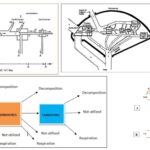IGCSE Biology 105 Views 1 Answers
Sourav PanLv 9November 15, 2024
Identify the lag, exponential (log), stationary and death phases in the sigmoid curve of population growth for a population growing in an environment with limited resources
Identify the lag, exponential (log), stationary and death phases in the sigmoid curve of population growth for a population growing in an environment with limited resources
Please login to save the post
Please login to submit an answer.
Sourav PanLv 9May 15, 2025
The sigmoid curve of population growth, also known as the logistic growth curve, illustrates how a population grows in an environment with limited resources. This curve is characterized by four distinct phases: lag phase, exponential (log) phase, stationary phase, and death phase. Here’s a detailed explanation of each phase:
1. Lag Phase
- Description: The lag phase is the initial stage of population growth where the growth rate is slow. During this period, individuals are adapting to their new environment.
- Characteristics:
- Few reproductive individuals are present, leading to minimal reproduction.
- Organisms are metabolically active, increasing in size and preparing for reproduction.
- Environmental conditions are being assessed, and necessary adaptations are occurring.
2. Exponential (Log) Phase
- Description: Following the lag phase, the population enters the exponential growth phase, characterized by rapid population increase.
- Characteristics:
- Resources (such as food and space) are abundant, allowing for high rates of reproduction.
- The number of individuals increases logarithmically, leading to a steep upward slope on the graph.
- Mortality rates are low due to favorable conditions, resulting in a high net growth rate as natality significantly exceeds mortality.
3. Stationary Phase
- Description: As resources become limited and competition increases, the population enters the stationary phase where growth stabilizes.
- Characteristics:
- The birth rate declines as resources become scarce, while mortality rates may rise due to increased competition and limited food supply.
- The population size levels off as natality equals mortality, resulting in a plateau on the graph.
- This phase reflects the carrying capacity (KK) of the environment, where the population oscillates around a stable size.
4. Death Phase
- Description: In some contexts, particularly in microbial studies, a death phase may be identified following the stationary phase.
- Characteristics:
- The death rate exceeds the birth rate due to factors such as resource depletion and accumulation of waste products.
- Population size begins to decline as individuals die off faster than new individuals can be born.
- This phase highlights the consequences of prolonged resource limitation and environmental stress
0
0 likes
- Share on Facebook
- Share on Twitter
- Share on LinkedIn
0 found this helpful out of 0 votes
Helpful: 0%
Helpful: 0%
Was this page helpful?




